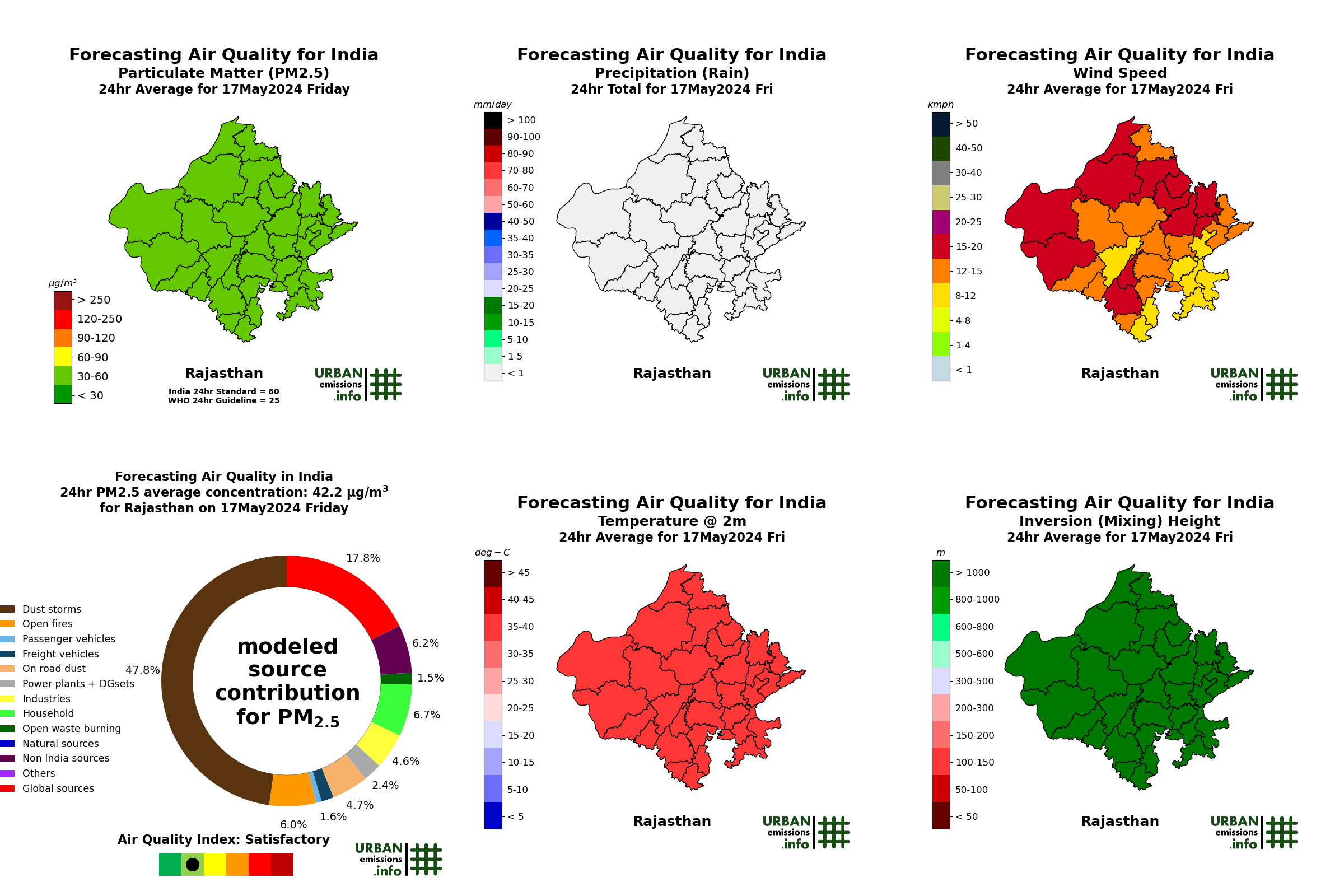Summary of PM2.5 Pollution and Meteorology Forecast for Today at the state-level (more resources here)
Jodhpur or the Blue City as its known because of the distinctive shade of blue that is used to colour houses in the old city, lies in the Thar Desert in the state of Rajasthan. Since it lies on the route between Gujarat and Delhi, Jodhpur emerged as an important trading hub in the past. A former princely state of Marwar, it is now a popular tourist destination with several attractions such as forts, palaces, temples and handicrafts.
The handicraft and tourism sector are the main economic drivers. Wheat and red chillies are the main agricultural exports from the district. Because of its proximity to the Pakistan border at 250 kms, the Indian Army, Air Force and Border Security Forces have a significant presence in the city.
![]() Geographically, Jodhpur has access to materials used in the construction sector industry such as Sandstone, Rhyolite, Dolomite, Limestone, Jasper and Granite and accordingly stone processing is an important industry.
Geographically, Jodhpur has access to materials used in the construction sector industry such as Sandstone, Rhyolite, Dolomite, Limestone, Jasper and Granite and accordingly stone processing is an important industry.
As of the 2011 Indian census, Jodhpur city has a total population of about a million covering an area of about 214 square kilometers. To assess Jodhpur’s air quality, we selected an airshed covering 30km x 30km. This domain is further segregated into 1km grids, to study the spatial variations in the emission and the pollution loads.
Meteorology fields are important as they have a direct impact on air pollution concentrations. During periods of high precipitation or high speed winds, emissions from a city are swept away and do not have an impact on concentrations. On the other hand, during the winter months when temperatures and inversion heights are low, there is a greater impact of emissions on pollution concentrations. Low temperatures also affect behaviour through the need for space and water heating – which in turn has increases emissions.
We processed the NCEP Reanalysis global meteorological fields from 2010 to 2018 through the 3D-WRF meteorological model. A summary of the data for one year, averaged for the city’s airshed is presented below by month. Download the processed data which includes information on year, month, day, hour, precipitation (mm/hour), mixing height (m), temperature (C), wind speed (m/sec), and wind direction (degrees) – key parameters which determine the intensity of dispersion of emissions.

Multi-Pollutant Emission Inventory
We compiled an emissions inventory for the Jodhpur region for the following pollutants – sulfur dioxide (SO2), nitrogen oxides (NOx), carbon monoxide (CO), non-methane volatile organic compounds (NMVOCs), carbon dioxide (CO2); and particulate matter (PM) in four bins (a) coarse PM with size fraction between 2.5 and 10 μm (b) fine PM with size fraction less than 2.5 μm (c) black carbon (BC) and (d) organic carbon (OC), for year 2015 and projected to 2030. In Phase 1, base year for all the calculations was 2015. In Phase 2, all the calculations are updated for year 2018.
 We customized the SIM-air family of tools to fit the base information collated from disparate sources. Apart from the official reports, resource material ranges from GIS databases of land use, land cover, roads and rail lines, water bodies, built up area (represented in the adjacent figure), commercial activities (such as hotels, hospitals, kiosks, restaurants, malls, cinema complexes, traffic intersections, worship points, industrial hubs, and telecom towers), to population density and meteorology at the finest spatial resolution possible (1-km). A detailed description of these resources is published as a journal article in 2019, which also includes a summary of baselines and pollution analysis for 20 Indian cities.
We customized the SIM-air family of tools to fit the base information collated from disparate sources. Apart from the official reports, resource material ranges from GIS databases of land use, land cover, roads and rail lines, water bodies, built up area (represented in the adjacent figure), commercial activities (such as hotels, hospitals, kiosks, restaurants, malls, cinema complexes, traffic intersections, worship points, industrial hubs, and telecom towers), to population density and meteorology at the finest spatial resolution possible (1-km). A detailed description of these resources is published as a journal article in 2019, which also includes a summary of baselines and pollution analysis for 20 Indian cities.
This emissions inventory is based on available local activity and fuel consumption estimates for the selected urban airshed (represented in the grid above). This information is collated from multiple agencies ranging from the central pollution control board, state pollution control board, census bureau, national sample survey office, ministry of road transport and highways, annual survey of industries, central electrical authority, ministry of heavy industries, and municipal waste management, and publications from academic and non-governmental institutions.
For the road transport emissions inventory, besides the total number of vehicles and their usage information, we also utilized vehicle speed information to spatially and temporally allocate the estimated emissions to the respective grids. This is a product of google maps services. For the city of Jodhpur, we extracted the speed information for representative routes across the city for multiple days. This data is summarized below for a quick look.
 |
Click here for gridded anime |
 |
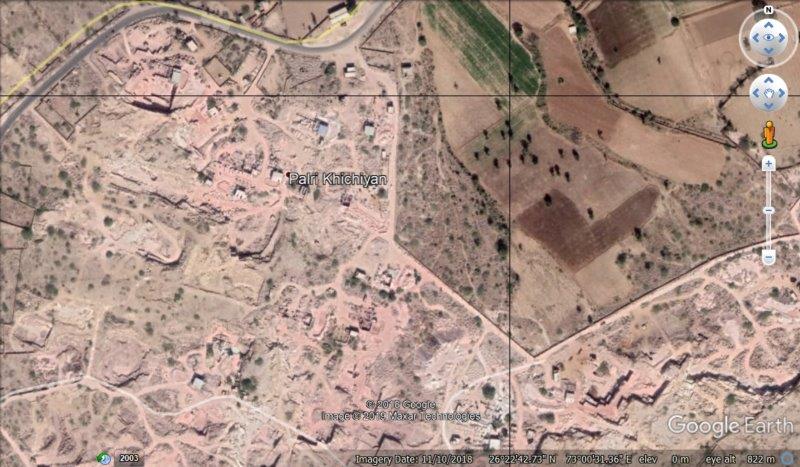 |
 |
 |
 |
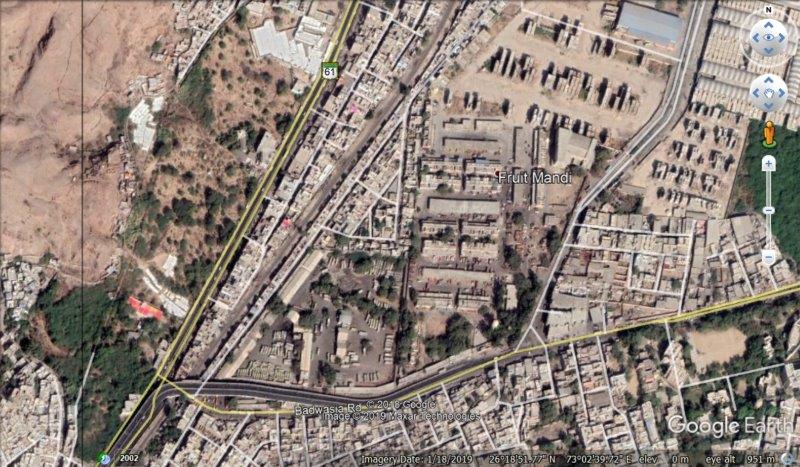 |
The summary for a city’s emissions inventory does not include natural emission sources (like dust storms, lightning, and seasalt) and seasonal open (agricultural and forest) fires. However, these are included in the overall chemical transport modeling in the national scale simulations. These emission sources are accounted in the concentration calculation as an external (also known as boundary or long-range) contribution to the city’s air quality.
Projections to 2030 under the business as usual scenario are influenced by the city’s social, economic, landuse, urban, and industrial layout and hence the projected (increasing and decreasing) rates that we assume are an estimate only. We based the vehicle growth rate on the sales projection numbers; industrial growth on the gross domestic product of the state; domestic sector, construction activities, brick demand, diesel usage in the generator sets, and open waste burning on population growth rates and notes from the municipalities on plans to implement waste management programs. We used these estimates to evaluate the trend in the total emissions and their likely impact on ambient PM2.5 concentrations through 2030.
The emissions inventory was then spatially segregated at a 0.01° grid resolution in longitude and latitude (equivalent of 1 km) to create a spatial map of emissions for each pollutant (PM2.5, PM10, SO2, NOx, CO and VOCs). The gridded PM2.5 emissions and the total (shares by sector) emissions are presented below.
Gridded PM2.5 Emissions (2018 and 2030)
 |
 |
Total PM2.5 Emissions by Sector 2018-2030
 |
 |
 |
TRANS = transport emissions from road, rail, aviation, and shipping (for coastal cities); RESIDEN = residential emissions from cooking, heating, and lighting activities; INDUS = industrial emissions from small, medium, and heavy industries (including power generation); ALL.DUST = dust emissions from road re-suspension and construction activities; W.BURN = open waste burning emissions; DG.SETS = diesel generator set emissions; B.KILNS = brick kiln emissions (not included in the industrial emissions)
Total Estimated Emissions by Sector for 2018 (units – tons/year)
| Jodhpur | PM2.5 | PM10 | BC | OC | NOx | CO | VOC | SO2 |
|---|---|---|---|---|---|---|---|---|
| Transport emissions from road, rail, aviation, and shipping (for coastal cities) | 4,050 | 4,250 | 1,700 | 1,300 | 17,900 | 115,600 | 26,000 | 250 |
| Residential emissions from cooking, heating, and lighting activities | 1,000 | 1,050 | 200 | 550 | 150 | 14,100 | 1,800 | 100 |
| Industrial emissions from small, medium, and heavy industries (including power generation) | 2,050 | 2,050 | 750 | 400 | 1,400 | 2,850 | 350 | 550 |
| Dust emissions from road re-suspension and construction activities | 5,900 | 38,050 | - | - | - | - | - | - |
| Open waste burning emissions | 600 | 600 | 50 | 350 | - | 2,750 | 550 | - |
| Diesel generator set emissions | 400 | 400 | 200 | 100 | 2,550 | 8,100 | 3,650 | 50 |
| Brick kiln emissions (not included in the industrial emissions) | - | - | - | - | - | - | - | - |
| 14,000 | 46,400 | 2,900 | 2,700 | 22,000 | 143,400 | 32,350 | 950 |
Chemical Transport Modeling
We calculated the ambient PM2.5 concentrations and the source contributions, using gridded emissions inventory, 3D meteorological data (from WRF), and the CAMx regional chemical transport model. The model simulates concentrations at 0.01° grid resolution and sector contributions for the urban area, which include contributions from primary emissions, secondary sources via chemical reactions, and long range transport via boundary conditions (represented as “boundary” in the pie graph below).
 |
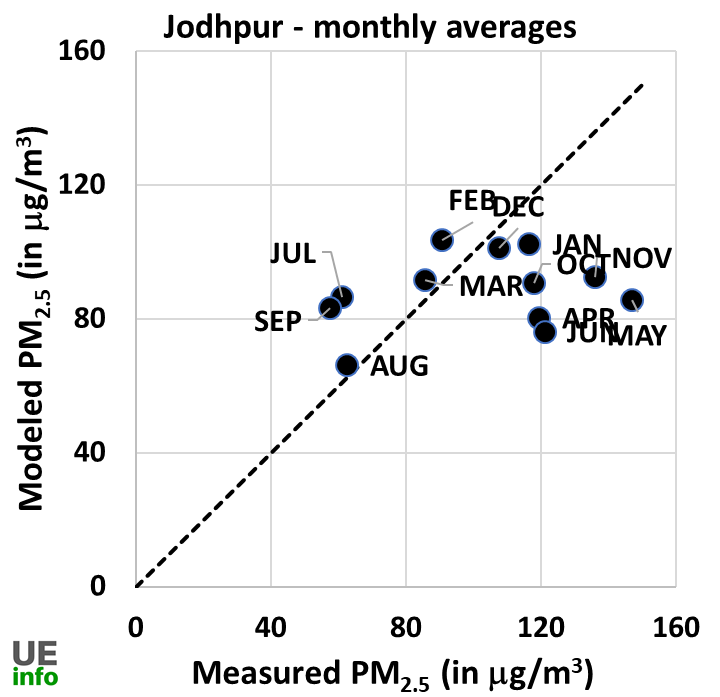 |
The ribbon graph shows the variation for average PM2.5 pollution by month. Due to precipitation during the monsoon, usually pollution levels dip and may fall within national air pollution standards, however most cities are unable to attain these standards at other times of the year. We consolidated all the PM2.5 data from the continuous monitoring stations operating within the modeling domain, for the period of 2018-19 and compared against the model results. The scatter plot presents a comparison of 24-hr average PM2.5 concentrations by month. Modeled data is for the urban parts of the city.
The following is a map of annual average PM2.5 pollution for the city of Jodhpur. The main sources contributing towards PM2.5 in 2018 are in the pie-chart on the left. The change in contributions in 2030 from different sources are shown on the right.
 |
 |
 |
There is a temporal variation in source contributions and spatial contributions depending on meteorological factors. We have a map of monthly average PM2.5 levels as well as their source contributions for every month in the charts below.
 |
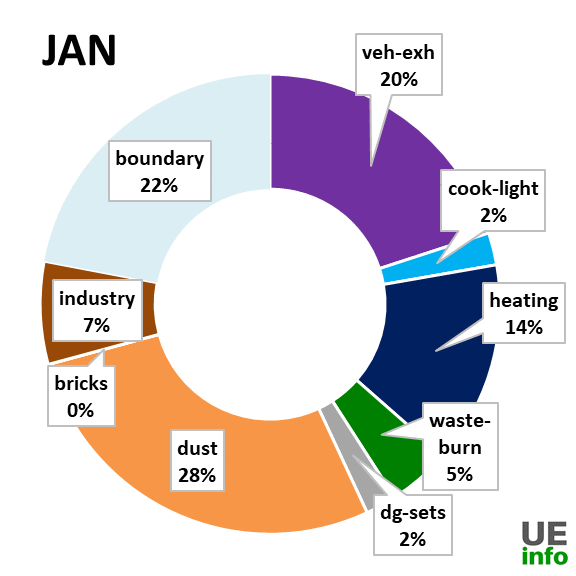 |
Satellite Data Derived Surface PM2.5 Concentrations
The results of satellite data derived concentrations are useful for evaluating annual trends in pollution levels and are not a proxy for on-ground monitoring networks. This data is estimated using satellite feeds and global chemical transport models. Satellites are not measuring one location all the time, instead, a combination of satellites provide a cache of measurements that are interpreted using global chemical transport models (GEOS-Chem) to represent the vertical mix of pollution and estimate ground-based concentrations with the help of previous ground-based measurements. The global transport models rely on gridded emission estimates for multiple sectors to establish a relationship with satellite observations over multiple years. These databases were also used to study the global burden of disease, which estimated air pollution as the top 10 causes of premature mortality and morbidity in India. A summary of PM2.5 concentrations for the period of 1998 to 2016 for the city of Jodhpur is presented below. The global PM2.5 files are available for download and further analysis @ Dalhousie University.
The graphs for other district PM2.5 concentrations for this period, maps of national averages, and year-wise changes are available here. The data for district level PM2.5 concentrations for 1998-2016 period for can downloaded here.
Monitoring
We present below a summary of the ambient monitoring data available under the National Ambient Monitoring Program (NAMP), operated and maintained by the Central Pollution Control Board (CPCB, New Delhi, India). In Jodhpur, as of November 2018, there are 0 continuous and 2 manual air quality stations in operation. An archive of all the data from the NAMP network from stations across India for the period of 2011-2015 is available here.
 |
 |
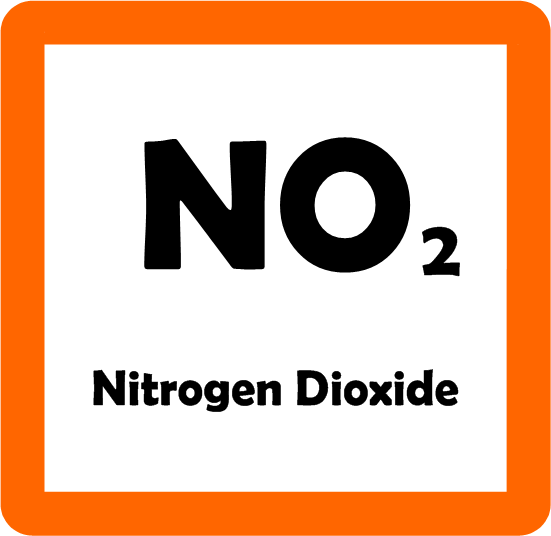 |
Resource Material
- CPCB repository of continuous air monitoring data (Link)
- CPCB List of non-attainment cities (Link)
- City Master Plan 2031, Jodhpur Development Authority (Link)
- NAMP Monitoring Data, Rajasthan State Pollution Control Board (Link)
- Report of the Comptroller and Auditor General of India on Economic Sector for the year ended 31 March 2017: Government of Rajasthan Report No. 5 of the year 2017. Pages 3-5, 11-47 (Link)
- Jodhpur Nagar Nigam (Municipal Corporation) (Link)
- “Draft Master Plan-2042 for Jodhpur-Pali-Marwar Industrial Area, Rajasthan Sub Region of DMIC”, Delhi Mumbai Industrial Corridor Department, Govt. of Rajasthan. (2016) (Link)
- “Rajasthan – the Solar Destination and Development of Bhadla Solar Park”, Government of Rajasthan Energy Department. (2018) (Link)
- “Solar plants of 620 MW get operational at Bhadla park”, Times of India. (2018) (Link)
- “Government’s solar park push is running into land acquisition and transmission challenges”, The Economic Times. (2019) (Link)
- “Mining Activity and its Impact on the Environment:Study from Makrana Marble and Jodhpur Sandstone Mining Areas of Rajasthan”, Bhadra, B.K. et. al. (2007) (Journal Article Link)
- “Municipal solid waste management in Jodhpur city, Rajasthan (India) – current status”, Ambade, R. B. et. al. (2013) (Journal Article Link)
Back to the APnA page.
All the analysis and results are sole responsibility of the authors @ UrbanEmissions.Info. Please send you comments and questions to simair@urbanemissions.info

